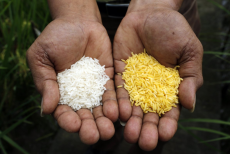
Email: emanuelealbertocirello.98@gmail.com
Total Article : 76
About Me:I am a Year 13 student which aspires to be an architect. I am interested in anything I don't yet know, and I mostly write about art, politics , Italian culture and inspirational people, although I will try to write for as many categories possible, just to test myself and get to know more things.

The use of new technologies cannot always guarantee a positive impact; if technologies are able to provide solution for the short term, time can show that on the long run they may have costs, impacts and negative externalities that might discourage the continued use of a specific technology and favour the development of another.
The Gene Revolution and the Green Revolution are examples of how new technologies have shown to be able to provide some benefits, but also many social and environmental costs. The Green Revolution brought the use of rapid growing variety of rice that had a yield 10 times higher than normal and the Gene Revolution produced genetically engineered golden rice, which was herbicide resistance, and reduced famine in Philippines. They, however, caused social polarisation and monoculture practices has significant costs. Social polarisation has caused an intense social impact on smaller farmers that were not able to afford machinery, labour and resources to produce golden rice and therefore became landless labourers and lost their small-scale businesses. Environmentally, monocultures have been the cause for new plant diseases, intensive water use and soil degradation due to the lack of variety of seeds cultivated. From further reading, the extensive use of chemically engineered crops has shown to the leading of nitrates and phosphate pollution to ecosystems (eutrophication), affecting wildlife in regions such as Oaxaca, Mexico, where maize land acres were found with transgenes.
The introduction of CFCs compounds in 1920s was used in refrigerators to store food, vaccines and medicines and used in 1940s as a propellant for spray cans. However, in the early 70’s the scientist community has linked the widespread use of this compound to the enlargement of the ozone’s hole, and its relation to climate change, and it was therefore banned in 1987.
Geoengineering technologies that have been lately developed to reduce and prevent global warming have many impacts too. Ocean fertilisation for example consists of adding iron to ocean waters to grow plankton; however, this technology has been recognised by the UN as a serious threat to biodiversity due to the acidification of the water that would be caused. Synthetic trees development has also shown to negatively affect the environment, as thousands of trees would have to cover large amounts to space, that could affect the mass production of crop and affect the population’s need for food.
Many megaprojects have recently been develop high-income consumer economy. China has been one of the most active countries in the development of megaprojects involving water technology. The Three Gorges Dam is a multipurpose dam with the goal of producing 23 thousands MW of electricity, but has however caused the flooding on many historic sites, the displacement of 4 million people that lived in rural agricultural communities and increased water pollution, and therefore threatening species such as the Siberian crane.
The widespread of leap frogging has allowed millions of people in the developing world to access technologies new for them. The rise of cars has followed the massive increase in population in countries such as India, with 60-70 million vehicles as of 2016 that have added huge amounts of pollutants in the atmosphere and affects the health of many communities due to respiratory diseases, acid rains.
To conclude, the costs of the adoption of new technologies are therefore greater in developing countries, where governments often find themselves pressured by the international community to make an environmental change even though their level of development is much lower and their access to resources is reduced.
Image credits: http://www.businessinsider.com/what-is-golden-rice-2014-6?IR=T

0 Comment:
Be the first one to comment on this article.